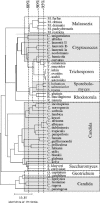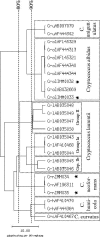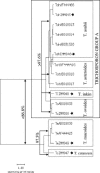Internal transcribed spacer sequencing versus biochemical profiling for identification of medically important yeasts
- PMID: 16390952
- PMCID: PMC1351945
- DOI: 10.1128/JCM.44.1.77-84.2006
Internal transcribed spacer sequencing versus biochemical profiling for identification of medically important yeasts
Abstract
In this study, we established an in-house database of yeast internal transcribed spacer (ITS) sequences. This database includes medically important as well as colonizing yeasts that frequently occur in the diagnostic laboratory. In a prospective study, we compared molecular identification with phenotypic identification by using the ID32C system (bioMérieux) for yeast strains that could not be identified by a combination of CHROMagar Candida and morphology on rice agar. In total, 113 yeast strains were included in the study. By sequence analysis, 98% of all strains were identified correctly to the species level. With the ID32C, 87% of all strains were identified correctly to the species or genus level, 7% of the isolates could not be identified, and 6% of the isolates were misidentified, most of them as Candida rugosa or Candida utilis. For a diagnostic algorithm, we suggest a three-step procedure which integrates morphological criteria, biochemical investigation, and sequence analysis of the ITS region.
Figures




Similar articles
-
Internal transcribed spacer region sequence analysis using SmartGene IDNS software for the identification of unusual clinical yeast isolates.Med Mycol. 2012 Jul;50(5):458-66. doi: 10.3109/13693786.2011.630683. Epub 2011 Nov 22. Med Mycol. 2012. PMID: 22103344
-
Four cases of Candida albicans infections with isolates developing pink colonies on CHROMagar Candida plates.Mycoses. 2005 Nov;48(6):378-81. doi: 10.1111/j.1439-0507.2005.01146.x. Mycoses. 2005. PMID: 16262872
-
Identification of medically important yeasts by sequence analysis of the internal transcribed spacer and D1/D2 region of the large ribosomal subunit.Rev Iberoam Micol. 2019 Jul-Sep;36(3):129-138. doi: 10.1016/j.riam.2019.05.002. Epub 2019 Nov 2. Rev Iberoam Micol. 2019. PMID: 31690527
-
Takashi Nakase's last tweet: what is the current direction of microbial taxonomy research?FEMS Yeast Res. 2019 Dec 1;19(8):foz066. doi: 10.1093/femsyr/foz066. FEMS Yeast Res. 2019. PMID: 31816016 Review.
-
Sequencing as a tool in yeast molecular taxonomy.Can J Microbiol. 1999 Nov;45(11):949-58. doi: 10.1139/w99-094. Can J Microbiol. 1999. PMID: 10588043 Review.
Cited by
-
First case report of bloodstream infection due to a Candida species closely related to the novel species Candida pseudorugosa.J Clin Microbiol. 2012 Jun;50(6):2165-9. doi: 10.1128/JCM.00167-12. Epub 2012 Mar 29. J Clin Microbiol. 2012. PMID: 22461681 Free PMC article.
-
Dual DNA Barcoding for the Molecular Identification of the Agents of Invasive Fungal Infections.Front Microbiol. 2019 Jul 18;10:1647. doi: 10.3389/fmicb.2019.01647. eCollection 2019. Front Microbiol. 2019. PMID: 31379792 Free PMC article.
-
Practical method for detection and identification of Candida, Aspergillus, and Scedosporium spp. by use of rolling-circle amplification.J Clin Microbiol. 2008 Jul;46(7):2423-7. doi: 10.1128/JCM.00420-08. Epub 2008 May 21. J Clin Microbiol. 2008. PMID: 18495860 Free PMC article.
-
Molecular Characterization of the N-Acetylglucosamine Catabolic Genes in Candida africana, a Natural N-Acetylglucosamine Kinase (HXK1) Mutant.PLoS One. 2016 Jan 25;11(1):e0147902. doi: 10.1371/journal.pone.0147902. eCollection 2016. PLoS One. 2016. PMID: 26808192 Free PMC article.
-
Antifungal Susceptibility Testing of Malassezia spp. with an Optimized Colorimetric Broth Microdilution Method.J Clin Microbiol. 2017 Jun;55(6):1883-1893. doi: 10.1128/JCM.00338-17. Epub 2017 Apr 5. J Clin Microbiol. 2017. PMID: 28381607 Free PMC article.
References
-
- Agarwal, J., S. Bansal, G. K. Malik, and A. Jain. 2004. Trends in neonatal septicemia: emergence of non-albicans Candida. Indian Pediatr. 41:712-715. - PubMed
-
- Chen, S. C. A., C. L. Halliday, and W. Meyer. 2002. A review of nucleic acid-based diagnostic tests for systemic mycoses with an emphasis on polymerase chain reaction-based assays. Med. Mycol. 40:333-357. - PubMed
-
- Chen, Y. C., J. D. Eisner, M. M. Kattar, S. L. Rassoulian-Barrett, K. LaFe, S. L. Yarfitz, A. P. Limaye, and B. T. Cookson. 2000. Identification of medically important yeasts using PCR-based detection of DNA sequence polymorphisms in the internal transcribed spacer 2 region of the rRNA genes. J. Clin. Microbiol. 38:2302-2310. - PMC - PubMed
-
- Eggimann, P., J. Garbino, and D. Pittet. 2003. Epidemiology of Candida species infections in critically ill non-immunosuppressed patients. Lancet Infect. Dis. 3:685-702. - PubMed
Publication types
MeSH terms
Substances
LinkOut - more resources
Full Text Sources
Other Literature Sources
Medical

